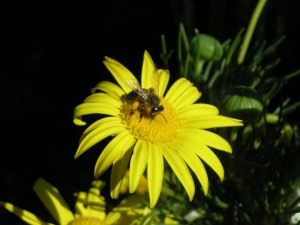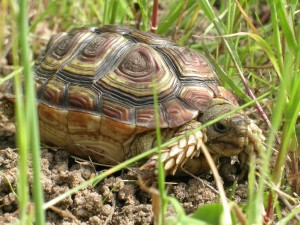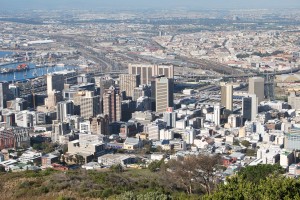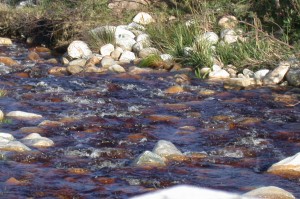MIRACLES < OF HOPE: SURVIVING AND THRIVING IN THE 21ST CENTURY
Foreword by Dr Ian Player …
In the Greek story about Pandora’s Box, Pandora is overcome with curiosity despite being warned not to open the box. She does so and all the evils in the world fly out to plague mankind. Only one bee is left and it is the bee of hope.
 Carole Knight’s book brings our attention to all the problems of “blackness and despair” that prevail in the 21st Century. We ignore them at our peril but we must hold onto the bee of hope. Carole Knight deals with both and in bringing information from a huge field of research; the book makes us ponder about the fate of the earth and all its inhabitants including ourselves. This is a book that all people can profitably read – both scientists and lay people alike.
Carole Knight’s book brings our attention to all the problems of “blackness and despair” that prevail in the 21st Century. We ignore them at our peril but we must hold onto the bee of hope. Carole Knight deals with both and in bringing information from a huge field of research; the book makes us ponder about the fate of the earth and all its inhabitants including ourselves. This is a book that all people can profitably read – both scientists and lay people alike.
Ecology has always been the central science and in the materialistic haste of the Western world we have shut our eyes to the long trail of disaster that has followed in the wake of what can only be described as the greed of modern man. With a critical and analytical approach Carole Knight highlights our successive failures in not coming to grips with ecological thinking. She writes in an easy to understand style but chooses her words carefully. The stupidity of our species is plain to see for those who care about the earth and our future.
Doom and gloom has become the stock in trade of the modern environment and with good reason. The decline of the world fisheries alone is more than enough to send us into the slough of despond.
I recall how after returning from the 2nd World War at the age of 19 and with no skills I went to the North Coast of KwaZulu-Natal and earned my living catching fish with rod and line. Today 56 years later, I would starve to death. It is a story repeated worldwide on a massive scale. But Carole Knight’s book does not dwell on the dismal. It reminds us of our potential to tackle problems and solve them in new ways. She brings a balanced perspective and after reading about all the problems she provides an antidote to the tendency to sink into negativity. Again I am reminded of my own experience in the late 1950’s when we faced the challenge of the White Rhino becoming extinct. We overcame the technical and political problems and from a small number of 437 White Rhino in 1953, there are now 12 000 in the world. A small team of dedicated people made the difference.
Given a chance and a rest Nature responds with amazing rapidity and this is the central message of this fine book. Listen to Nature, work with her and she will respond.
The bee of hope in Pandora’s Box is brought to life by Carole Knight and becomes a beacon of light and a clarion call to the collective unconscious of mankind, to wake up and do what Nature expects us to do. Work towards a better understanding of where we have come from and how bright a future awaits us if we put our minds, hearts and souls into our work for the Earth.
Ian Player D.M.S.
Preface
Speeding silently through the deep darkness of outer space, our planet is a unique and wondrous place. Encapsulated by an ethereal blue band of atmosphere, its sea, continents and swirling clouds appear to space-travellers to be tranquil and self-contained. It is a tiny speck in a universe believed to be billions of light years across. And yet it alone appears to harbour life.
 Through aeons of time, as our world has tilted and spun its way around its sun, it has sheltered myriad living organisms. Billions of life forms have come and gone in wave after wave of evolution and extinction, some to leave traces of their passing and others not. As the great continental slabs of the Earth have drifted their way around the globe, this life has evolved into a pinnacle form. That of human intelligence. A human capacity so powerful that it has literally shaped the face of the Earth.
Through aeons of time, as our world has tilted and spun its way around its sun, it has sheltered myriad living organisms. Billions of life forms have come and gone in wave after wave of evolution and extinction, some to leave traces of their passing and others not. As the great continental slabs of the Earth have drifted their way around the globe, this life has evolved into a pinnacle form. That of human intelligence. A human capacity so powerful that it has literally shaped the face of the Earth.
Satellite photographs from outer space show massive areas of the continents to be cubed neatly into buildings, parks, highways and streets according to humanity’s will. But this has only recently been the case. For almost our entire brief sojourn on Earth, our species Homo sapiens (thinking Man) has existed through the means provided by hunting and gathering, depending on the natural world for sustenance and shelter. Even after civilising ourselves and taming the plants and animals of our world to provide our bidding, we still relied on the air, water, seasons and soil for our survival.
Recently however, over much of the Earth’s surface this ancient status quo has been reversed. We now have the means to grow our food in plastic structures, artificially lit and artificially earthed. We are able through genetic engineering to reproduce our livestock in a laboratory far away from any grassy field. Our homes are human-made and human-powered and we have the technology to harness an energy source that is the basic power of the universe. There can be no doubt that through both voluntary and involuntary means we are reshaping the crust of the Earth. Even the heavens and the sea have been infiltrated by our interference. Thus for probably the first time in the millions of years of their existence the landmasses, sea and sky have lost their exclusive dominion. So where to from here?
Historically our species has gained its strength from the equation of nature as master over humankind. From the earliest times environmental pressures provided the impetus for the cultural and technological developments that enabled our ancestors to survive, prosper and multiply on Earth. As our forefathers marched before the onslaught of ice, flood or drought they grew clever and strong.
They learned ingenuity through the need to adapt to geological diversity. The changing seasons gave them a sense of time. Co-operative effort, tools and language developed out of a need to hunt the huge-bodied animals of their ice age world. Art, image and notation as a means of self-expression, imitated the abundant animal and plant life that roamed and grew around them. And even the spiritual life of the ancients was guided by the sprites of the forests, streams and skies.
 Thus for millennium after slumbering millennium, it was nature that shaped and nurtured human beings and human beings who submitted to nature. Now that this ancient status quo has been turned on its head, how will we as a species fare? Will our intelligence find a way through the maze of human congestion to an equitable future? Or, as many would have it, has the evolution of our intelligence outstripped our species’ capacity for wisdom, so that in the final analysis our brainpower, unharnessed by insight, will run away with us, leading to a catastrophe of technological self-destruction?
Thus for millennium after slumbering millennium, it was nature that shaped and nurtured human beings and human beings who submitted to nature. Now that this ancient status quo has been turned on its head, how will we as a species fare? Will our intelligence find a way through the maze of human congestion to an equitable future? Or, as many would have it, has the evolution of our intelligence outstripped our species’ capacity for wisdom, so that in the final analysis our brainpower, unharnessed by insight, will run away with us, leading to a catastrophe of technological self-destruction?
Certainly when one looks at incidents of historical and recent evidence, one can see a panoply of human errors pointing in this direction. Errors in thinking, errors in judgement, errors in planning and errors in behaviour spanning the centuries that human beings have walked the Earth. However this is only one side of a darkening picture. The flipside is our human capacity to rectify things if we can just have the time, wisdom, knowledge and will to do so. There can be no doubt that we are living in a time of unprecedented epochal significance when the fortunes of humankind could swing either way.
But it is not within the scope of this book to make predictions for the future. What this book does attempt to do is to provide a balanced perspective of the human condition and its relevance to these times we live in. It has been researched and written in direct response to the negative, overplayed version we have of ourselves, of a species of delinquent demi-gods running roughshod over the Earth as we trash every other life-form in our headlong flight into catastrophic oblivion. And it attempts to explore the human spirit in many of its multitudinous facets as a beacon of hope for the future. It is neither a superficial motivational manual nor an academic treatise. Rather it is a subjective exploration of the human spirit as an agent for ultimate survival.
Researching and writing this book was a six-year work of both joy and despair. Joy, because I discovered pockets of hope in the unlikeliest of places, and despair because I had not realised the full extent of human fecklessness. But in essence this very human duality is also what made the book such a challenging project. During the researching and writing of this book there were many times when I felt overwhelmed by the scope of what I was trying to achieve. In those times of doubt I would consciously recall the words of my dear father, who advised me to only take one step at a time at whatever endeavour I was trying to achieve. So Dad, this book is for you. May your footsteps in Heaven be eternally joyful ones.
Warriors of the Rainbow
As Eyes of Fire slowly came awake to the new day, she became aware of the familiar, comforting sounds of her Cree village also coming to life in the cold clear dawn. For a long moment she savoured the snug warmth of her caribou robe bed before turning her frail old body over to face the entrance flap on the opposite side of the tepee. It was still dark inside although shafts of bright sunlight danced through tiny holes in the large rawhide cone that was her family’s home. For as long as she could recall, it had been her custom to begin each new day with a greeting to the rising sun. And from her grandmotherly place of honour at the rear of the tepee facing East, Eyes of Fire was well placed to welcome these first playful sunbeams of the new morning.
It was an important time. Her youngest son was embarking on a vision quest prior to his entry into marriage and this was to be the day that he ventured on his own into the solitude of the distant mountains. Preparations for this sacred journey had engaged Eyes of Fire and the other female members of her clan for many moons. Caribou skins had been stretched tightly and lashed to a square frame of wooden poles.
Women in the village had helped to scrape the skins clean of all hair, fat and tissue. After washing in the creek, the skins had then been smoked over an open fire to give them a pleasing honey colour. And thus prepared, the supple skins had been lovingly stitched with sinew into garments and moccasins appropriate for this significant occasion. Foremost among the garments was a caribou robe that Eyes of Fire had decorated herself with elaborate beading and quillwork. It was to be worn about her son’s shoulders against the fierce mountain winds and freezing snows that he would encounter on his journey north, and with it went all her love and motherly blessings. Fish, meat and other foodstuffs had been gathered, dried and stored in a food bag. These supplies were to provide sustenance and strength for her son for the time ahead. All was ready. The crisp clear dawn would be a good time for her son to leave the Cree camp.
Eyes of Fire lingered a little while longer in her warm bed and then, resolutely drawing the caribou skin that covered her away from her body, she began to make her way across the floor of the tepee. In spite of the warmth generated by the still-smouldering fire and the huddled forms of her sleeping family, she could feel the bite of the sub-arctic dawn. Reaching the entrance flap she pushed the heavy rawhide skin away so that she could look out onto the new day. The world that greeted her was peaceful and pristine. Every tree, every lichen-covered rock, every snowy field was as it should be. Everything was reassuringly in its place according to the timeless pattern of the Earth Mother. Gathering her strength, the old woman stepped out of the tepee and stood for a moment, relishing the sights and sounds of the crisp early morning.
As she gazed about her, Eyes of Fire became aware of a darkening of her senses. It seemed as if the sun had suddenly been swallowed up by a low, black cloud that blanketed all sound and with the darkening the world seemed to quieten and shift and go out of focus. Faltering and losing her balance, Eyes of Fire fell painfully to her knees like a wounded caribou caught in a hunter’s cruel snare. And like the snared caribou she felt a rising wave of panic that threatened to engulf her. For what she saw in her mind’s eye was beyond her comprehension.
 How could it possibly be that the world would become ravaged? How could the deep, blue sea become blackened? How could the streams that had always run cold and clear over smooth brown pebbles become lifeless and poisoned? How could the deer in the snowy winter fields drop dead in their tracks without a hunter’s arrow? How could her People lose their spirit? How could the world change so that nothing was as it should be? And how could her People possibly survive in such a world?
How could it possibly be that the world would become ravaged? How could the deep, blue sea become blackened? How could the streams that had always run cold and clear over smooth brown pebbles become lifeless and poisoned? How could the deer in the snowy winter fields drop dead in their tracks without a hunter’s arrow? How could her People lose their spirit? How could the world change so that nothing was as it should be? And how could her People possibly survive in such a world?
After a time the fearful vision faded and Eyes of Fire rose shakily to her feet. She shook her old, grey head to clear the mist that had formed before her eyes. She knew what she must do. With the time left to her she must warn her People of what was to come. She, Eyes of Fire, must rally them and prepare them for the teaching of a future generation, so that they could in turn teach another future generation until just before it was too late, her People would regain their spirit and teach the white man to have reverence for the Earth; so that banding together they could become Warriors of the Rainbow….
You’ve got interesting articles here. Your website can go viral, you need some initial traffic only.
How to get initial traffic? Search google for: marihhu’s tips